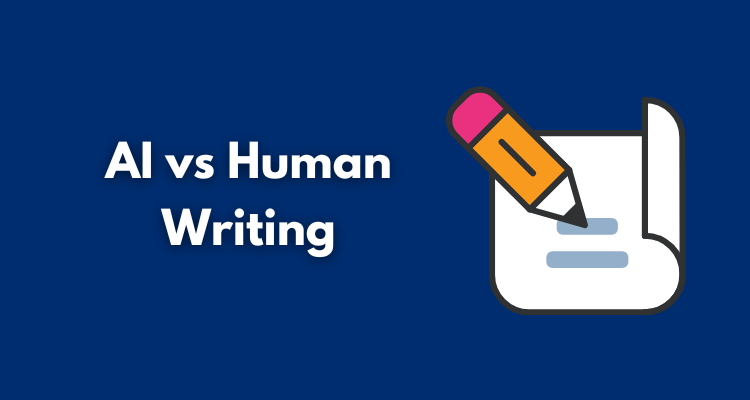For years, marketers, brand copy pros, and even essay writers have asked the same question: Can AI really compete with humans when it comes to writing content that performs? We decided to stop guessing and test it.
We ran a research project led by Michael Perkins, surveying and interviewing more than 160 professionals across industries. We compared the performance of AI writing and human writing across formats that matter most to digital marketing today: blogs, ads, emails, social media, landing pages, and even video/webinar scripts.
The results weren’t what we expected. In some cases, AI outperformed humans. In others, the human touch completely crushed the machine. And across the board, one truth stood out: the winners weren’t AI or humans alone – they were the marketers who learned how to use both together.

Source: https://www.pexels.com/photo/a-group-of-people-discussing-marketing-plans-6476255/
Table of Contents
ToggleHow Our Research on AI Writing vs Human Writing Was Conducted
We wanted this research to feel as real as possible. So, instead of running a lab experiment, we asked actual practitioners to share results from their own campaigns. Here’s how we structured it:
- Sample size: 160 participants from five categories.
- Participants: 40 freelance copywriters and content writers, 30 ghostwriters, 25 journalists, 20 academic/essay writers, 20 authors, and 25 marketers (ads, social, and video).
- Methods: 30 in-depth interviews (online and in-person), 100 structured questionnaires, and 30 follow-up conversations used for quotes and context.
- Anonymity policy: Participants are quoted under monikers to keep honesty high.
Evaluation Criteria
- Content quality and depth
- Engagement and reach
- Conversions and ROI
- Trust and authenticity
We also asked about AI tools for content creators: which platforms they use, how often, and whether AI was treated as a draft assistant, a testing tool, or a full replacement for writing.
AI vs Human Content-Wise – The Comparison Matrix
Here’s the heart of our findings:
| Content Type | AI Performs Better | Human Performs Better | Key Insight |
| Long-Form (blogs, articles, whitepapers) | 18% | 72% | Humans dominate SEO, depth, and originality. AI helps with speed, but struggles with nuance. |
| Short-Form (social media captions, ads) | 61% | 29% | AI wins with volume and A/B testing. Humans refine tone and personality. |
| Email Campaigns & Landing Pages | 54% | 38% | AI subject lines lift open rates; humans keep body copy engaging. |
| Video Scripts & Webinars | 23% | 68% | AI helps outline, but human delivery/storytelling makes content memorable. |
| Overall Trust & Brand Impact | 12% | 79% | Human-authored content builds long-term trust. AI alone feels generic. |
Michael Perkins notes: “Across the board, AI speeds things up, but the most effective marketers always add a human layer – editing, strategy, or storytelling. That’s where trust and differentiation come in.”
AI Marketing Content Performance
Marketing is where AI feels most disruptive – and most divisive.
AI-generated posts, ads, and email subject lines often performed better on surface-level metrics like click-through rates. Some participants even saw engagement spikes of 30-40% when using AI-assisted captions.
But as Michael Perkins explains, according to EssayWriters research, 72% of participants agreed that while AI marketing content boosted clicks, it didn’t build lasting trust. Human content was more likely to get shared, cited, or remembered.
That tension defined our study: AI gets attention, humans build connection.
Long-Form Content: Depth and Originality Win
When it comes to AI writing vs human writing for blogs and articles, humans still set the standard.
Rachel, content marketer:
“The AI draft looked fine, but it lacked substance. When I added examples and case studies, it finally ranked and converted.”
Our data backed this up. 72% of participants said their human-written blogs held top search positions longer. AI-generated posts ranked quickly but slipped after weeks.
Why? Search engines and readers both reward depth, originality, and narrative flow – things a human writer does naturally. AI tools can generate 2,000 words fast, but without fresh insights or a clear argument, the content feels thin.
Still, AI isn’t useless here. Many participants said they use AI writing tools to build outlines or first drafts, then edit heavily. That speeds up the process without sacrificing quality.
Short-Form Content: Speed and Testing Power
This is where AI shines. Social posts, paid ads, and headlines demand speed and variation – and machines thrive on both.
Marcus, ad copywriter:
“AI gave me dozens of headlines in seconds. Some were unusable, but a few outperformed anything I would have written solo.”
Our study showed that 61% of participants found AI-driven short-form content got higher CTRs. In ads especially, AI’s ability to churn variations and test emotional triggers delivered wins.
But the catch? Tone.
Clara, social media manager:
“Engagement improved with AI, but only after I rewrote captions to sound like us.”
AI is great at speed. Humans are great at voice. Together, they’re unstoppable.
Email Campaigns & Landing Pages: The Hybrid Zone
Emails are the unsung hero of digital marketing. And here, AI has carved out a clear niche: subject lines.
Our study showed 54% of participants said AI subject lines lifted open rates compared to human-written ones. The machine simply has more bandwidth to test words and phrasing combinations.
Hannah, email marketing lead:
“AI suggested subject lines that spiked our open rates. But the body copy still had to come from a professional copywriter.”
Landing pages followed a similar pattern. AI provided fast drafts, but 38% of marketers found human rewrites converted better. Emotional nuance, persuasion, and audience understanding still matter too much to leave to AI alone.
Video Scripts & Webinars: Storytelling Is a Human Trait
AI can draft a script, but can it hold an audience’s attention for 30 minutes? Our research says no.
Diego, webinar host:
“AI gave me a structured outline, but the parts people remembered were my stories and jokes.”
AI works well for outlines, scene planning, and translations. But for delivery, spontaneity, and emotional pull, the human content writer wins.
When asked which type of content made audiences stay engaged longer, 68% said human-written scripts kept viewers watching.

Source: https://www.pexels.com/photo/person-typing-on-laptop-1174775/
Trust & Brand Impact: Humans Lead, Full Stop
When it comes to brand trust, our participants were blunt: an AI content writer can’t replace a human voice.
Omar, brand strategist:
“Clients told us AI posts felt generic. Once we switched back to human-led storytelling, engagement jumped.”
In fact, 79% of respondents said human-created content built more credibility.
That doesn’t mean AI is useless here. It can still support AI content creation in the background (like transcripts, translations, or repurposing content). But for customer-facing messages, the human touch is non-negotiable.
Cost, Time, and ROI: The Practical Trade-Offs
Performance is one thing – budgets and deadlines are another.
Our research found AI cut content production time by 40-60% on average, especially for short-form and drafts. That meant lower upfront costs: fewer billable hours, more output per week.
But here’s the kicker: long-term ROI often favoured human-led content. Campaigns anchored by human-written assets (like cornerstone blogs or thought-leadership pieces) delivered stronger SEO performance and customer trust, which translated into better lifetime value.
Liam, e-commerce copywriter:
“AI cut our email costs in half. But the campaigns that converted best were still the ones I rewrote for voice.”
Michael Perkins summed it up: “AI saves time and money today, but human-crafted content pays dividends tomorrow. Smart teams use both.”
The insight? Don’t just chase speed. Think about ROI over months, not hours.
Using AI Writing Tools in Practice
Tools are only as good as how you use them. Our research found that most marketers rely on AI tools for writing in three ways and solutions like Question AI, are becoming a popular choice for generating ideas, structuring content, and improving clarity.
- Drafting: creating outlines or first drafts.
- Testing: generating multiple variations for ads or subject lines.
- Editing aid: improving grammar, tone, or clarity before final polish.
But the highest-performing teams never published raw AI content. They always layered human oversight.
Turning Insights Into Action: The Perkins Framework
So, how do you actually apply these results? Michael Perkins recommends a simple framework.
Segment-Specific Recommendations
- Long-form (blogs, articles): human-first, AI-supported.
- Short-form (ads, social posts): AI-first, human-edited.
- Emails & landing pages: hybrid workflow.
- Video & webinars: human-first, AI-assisted.
- Trust & brand content: human-led, AI in the background.
The Perkins Action Checklist
- Who’s in charge here – AI draft or human refinement?
- Does this content show a human fingerprint?
- Am I using AI to accelerate, not replace?
- Will my audience trust this?
The Framework in One Line
Assess → Augment → Audit
- Assess the content type.
- Augment with AI where speed/testing helps.
- Audit with human judgment before publishing.

Source: https://www.pexels.com/photo/person-holding-orange-and-white-paper-7172858/
Future Trends in AI Content Creation
What’s next? Our participants had strong opinions.
Eva, B2B communications lead:
“If everyone publishes AI text, standing out will mean doubling down on original human stories.”
Michael Perkins agrees. He predicts:
- More hybrid workflows: AI handling 70% of grunt work, humans polishing the final 30%.
- Personalisation at scale: AI customising copy for micro-segments, but humans providing the creative angles.
- Oversaturation risks: Audiences will get tired of generic AI phrasing – brands with authentic voices will win.
Prepare your team now. Train them not just to write, but to edit and humanize AI drafts.
Who Wins the AI vs Human Writers Battle?
AI can produce content faster, test variations at scale, and sometimes even outperform humans on clicks. But human writers still lead in trust, authenticity, and long-term performance.
In our study, marketers using a hybrid model – AI for speed, humans for depth – consistently saw the best results.
The future of AI content creation isn’t machines replacing people. It’s smart marketers learning to merge the best of both.
As Michael Perkins puts it, “AI is the engine. Humans are the driver. And together, they’ll take content marketing further than either could alone.”









